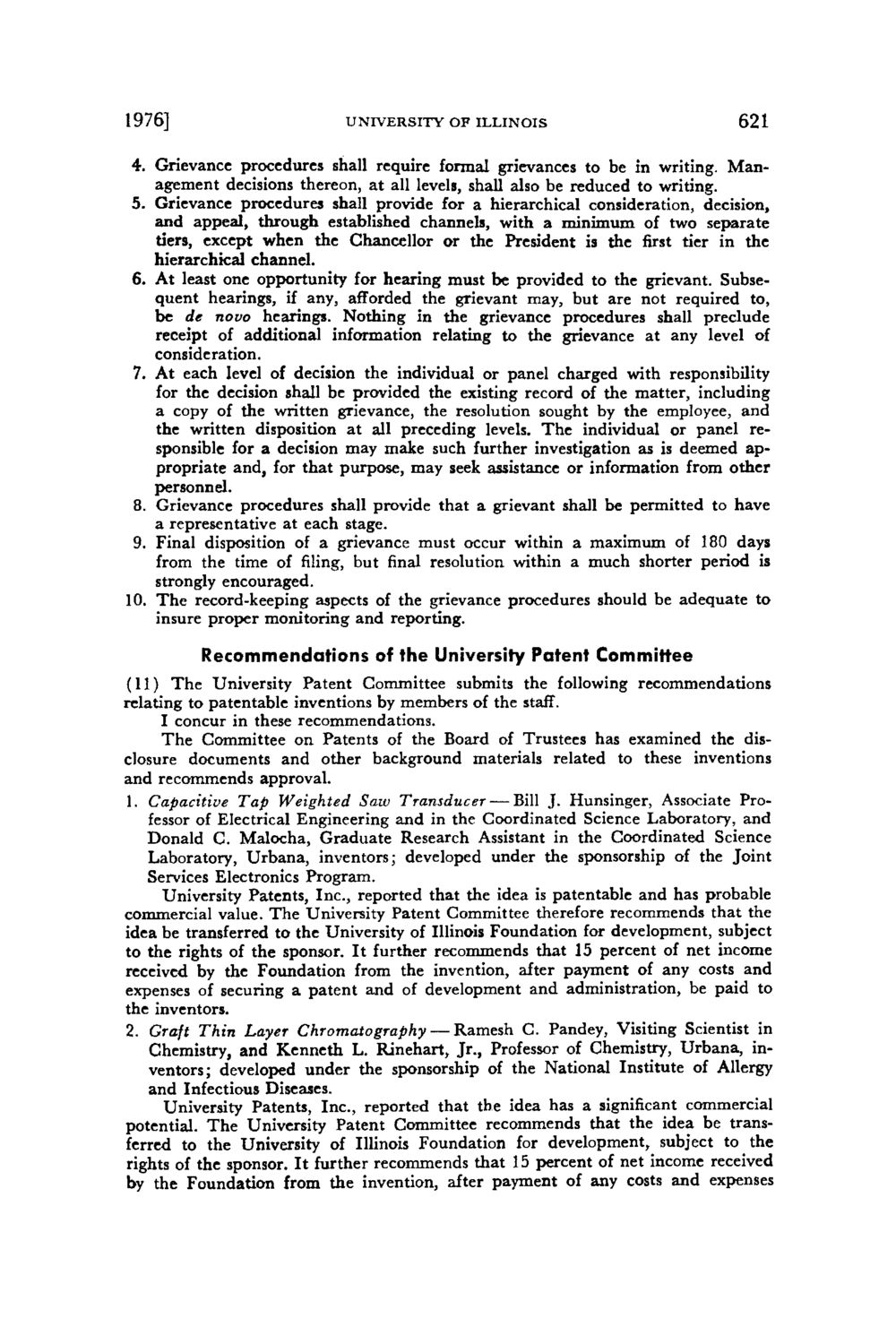| |
| |
Caption: Board of Trustees Minutes - 1976
This is a reduced-resolution page image for fast online browsing.

EXTRACTED TEXT FROM PAGE:
1976] UNIVERSITY OF ILLINOIS 621 4. Grievance procedures shall require formal grievances to be in writing. Management decisions thereon, at all levels, shall also be reduced to writing. 5. Grievance procedures shall provide for a hierarchical consideration, decision, and appeal, through established channels, with a minimum of two separate tiers, except when the Chancellor or the President is the first tier in the hierarchical channel. 6. At least one opportunity for hearing must be provided to the gricvant. Subsequent hearings, if any, afforded the grievant may, but are not required to, be de novo hearings. Nothing in the grievance procedures shall preclude receipt of additional information relating to the grievance at any level of consideration. 7. At each level of decision the individual or panel charged with responsibility for the decision shall be provided the existing record of the matter, including a copy of the written grievance, the resolution sought by the employee, and the written disposition at all preceding levels. T h e individual or panel responsible for a decision may make such further investigation as is deemed appropriate and, for that purpose, may seek assistance or information from other personnel. 8. Grievance procedures shall provide that a grievant shall be permitted to have a representative at each stage. 9. Final disposition of a grievance must occur within a maximum of 180 days from the time of filing, but final resolution within a much shorter period is strongly encouraged. 10. T h e record-keeping aspects of the grievance procedures should be adequate to insure proper monitoring and reporting. Recommendations of the University Patent Committee (11) T h e University Patent Committee submits the following recommendations relating to patentable inventions by members of the staff. I concur in these recommendations. T h e Committee on Patents of the Board of Trustees has examined the disclosure documents and other background materials related to these inventions and recommends approval. 1. Capacitive Tap Weighted Saw Transducer — Bill J. Hunsinger, Associate Professor of Electrical Engineering and in the Coordinated Science Laboratory, and Donald C. Malocha, Graduate Research Assistant in the Coordinated Science Laboratory, Urbana, inventors; developed under the sponsorship of the Joint Services Electronics Program. University Patents, Inc., reported that the idea is patentable and has probable commercial value. The University Patent Committee therefore recommends that the idea be transferred to the University of Illinois Foundation for development, subject to the rights of the sponsor. I t further recommends that 15 percent of net income received by the Foundation from the invention, after payment of any costs and expenses of securing a patent and of development and administration, be paid to the inventors. 2. Graft Thin Layer Chromatography — Ramesh C. Pandey, Visiting Scientist in Chemistry, and Kenneth L. Rinehart, Jr., Professor of Chemistry, Urbana, inventors; developed under the sponsorship of the National Institute of Allergy and Infectious Diseases. University Patents, Inc., reported that the idea has a significant commercial potential. T h e University Patent Committee recommends that the idea be transferred to the University of Illinois Foundation for development, subject to the rights of the sponsor. I t further recommends that 15 percent of net income received by the Foundation from the invention, after payment of any costs and expenses
| |